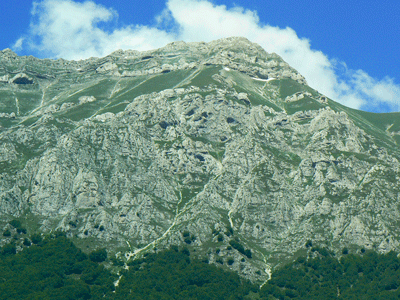It seems that every inch of Italy is “wine country,” though some areas are more popular than others. Popularity comes with a higher price and more fellow tourists to contend with. Even at the height of summer, Italy’s Adriatic coast is free of the hoards of tourists you’ll find on the Mediterranean side. In times past this area was harder to reach by land than by sea. It’s different today, as freeways string out from Rome, tunneling through granite, scaling the peaks and mountain passes, to deliver you on the eastern side of the peninsula in a couple of hours. Yet few tourists bother to take the trip.

The rugged Apennine Mountains loom above Abruzzo
For those looking for relatively untraveled wine roads, this is fascinating territory. If you’ve already visited the more famous Italian wine areas, drinking the wines and visiting the wineries you’ve read about, here’s your chance to drink local wines and visit wineries you may never have heard of before. Happily, the quality of most of these wines is excellent, and at a more reasonable price than more famous wines, such as Barolo, Brunello etc.
As you might expect, the land and the sea contribute equally to the local cuisine. Historically, this was an area of large estates worked by thousands of peasants, and the cuisine has its roots in the peasant traditions — cucina povera. Even in the late 1990s local restaurants were more likely to serve rustic renditions of the local fare — large portions and over-cooked. Today that’s changing. The ingredients are the same, but there is more finesse in both the cooking and the presentation.
When the large estates were broken up by the agrarian reforms of the 1950s, the former owners still retained some land, but much of it was divided among former peasant sharecroppers. Wine, like most of the agricultural produce, was intended for local consumption and held no more importance than olive oil or cheese. There was no tradition of fine wine production.
However, as Italy’s birthrate declined over the past 50 years, growers found it increasingly difficult to rely on local sales to sustain their businesses. The need to find something to export coincided with a significant explosion of quality wine around the world, as viticulture and viniculture became more scientific. This drew the attention of journalists, which in turn stimulated sales. As hitherto unknown winery owners became prominent and wealthy, others in the industry took note and began to systematically improve their local wines for international consumption. So it’s no wonder that, while these areas have an ancient tradition of winemaking, it’s only recently that they’ve begun to receive recognition for their quality.
For the wine tourist it’s only a two to three hour drive on wide autostradas from Rome to the Adriatic. The roads scale the lofty Apennines and afford majestic views of the mountains, and panoramas of the sea. For our purposes we’ll start with Molise in the south, and wind our way northward through Abruzzo and Marché, and though the vast majority of the wine is made by cooperative wineries, we’ll focus on the small, independent, family run cellars.
Click here to begin your tour in MOLISE.
Click here to continue your tour to ABRUZZO.
Click here to conclude your tour in MARCHE.
